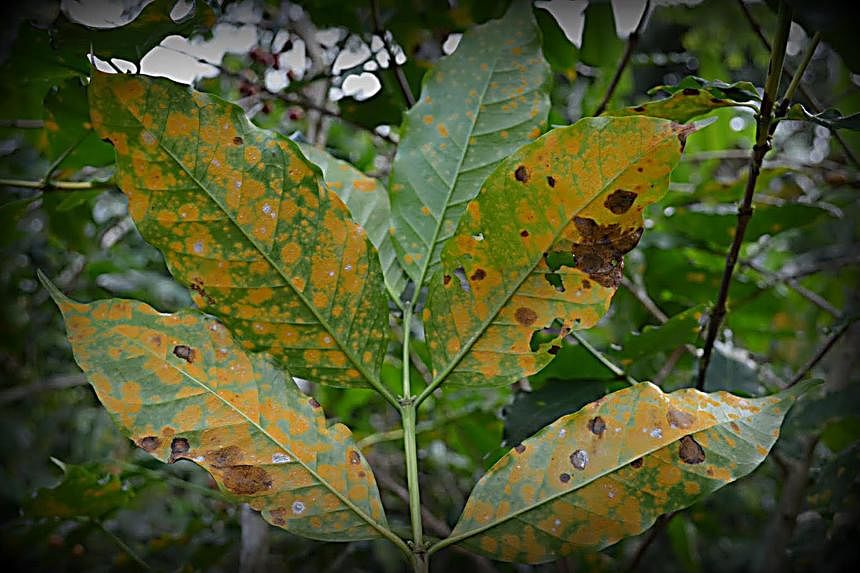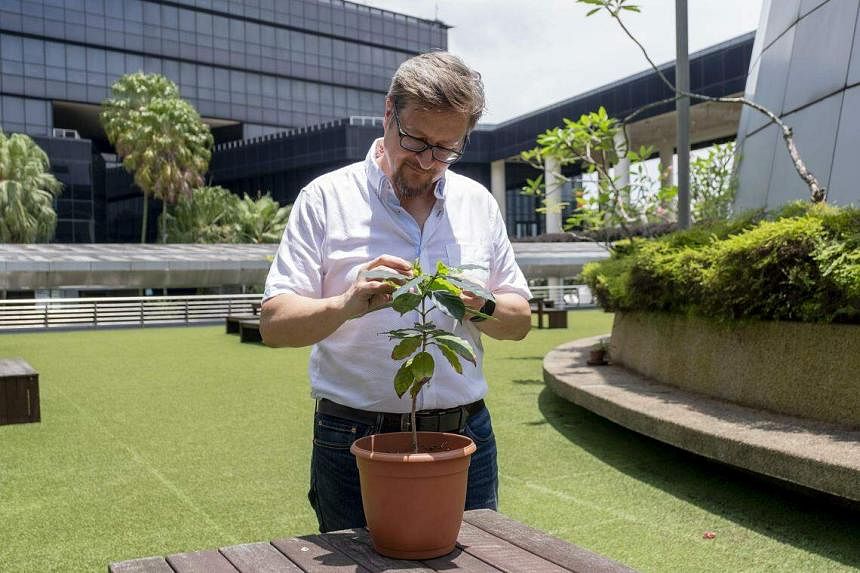
Arabica leaves affected by coffee leaf rust, a fungal disease that has no cure.
PHOTO: PURDUE UNIVERSITY/CATHERINE AIME
Shabana Begum
Shabana Begum
ST
JUL 15, 2024, 05:00 AM
SINGAPORE – The Robusta bean often used to brew cheaper cups of coffee – like the traditional Nanyang kopi – can save the more premium Arabica from a fungal disease.
For generations, Arabica plants, from which about 60 per cent of all coffee is produced, have been ravaged by an incurable fungal disease called coffee leaf rust.
Agriculture institutes in coffee-producing regions have been using selective breeding to confer the Robusta traits to Arabica plants, after a rust-resistant plant hybrid was found in Timor, Indonesia, in the 1920s.
Now, recent international research co-led by Nanyang Technological University (NTU) could optimise the breeding process. The study involved mapping the genomes of various coffee varieties, and the researchers zeroed in on the specific Robusta genes that are resistant to coffee leaf rust.
“For the Timor hybrid descendants, in every generation the hybrids have been crossed with an Arabica variety, the offspring’s Robusta content gets smaller and smaller,” said Assistant Professor Jarkko Salojarvi from NTU’s School of Biological Sciences, who led the research team.
Through identifying the resistant genes, the researchers found a means to enable more efficient targeted breeding of resistant plants, similar to targeted therapies against human diseases.
The study was done with Nestle and two universities in the United States and France.
When the coffee-hunting fungus attacks Arabica coffee plantations, it leaves brownish-orange spots on the leaves – much like rust on steel.
The Arabica leaves then wither and die off. Leaf loss lowers the amount and quality of coffee berries harvested, leading to great economic losses for farmers in Latin America and other places.
In 2020, the disease spread to Hawaii for the first time, and a 2015 outbreak in the Mexican state of Oaxaca caused a 50 per cent loss in yields.
While farmers have used fungicides as well as pruning and weed management to drive out the pesky fungus, the best way to control it is through the use of resistant cultivars, said Dr Luiz Filipe Pereira, a researcher at the Brazilian Agricultural Research Corporation (Embrapa).
Since the 1970s, the Arabica-Robusta hybrid from Timor and its descendants have been cross-bred with the preferred Arabica plants to create rust-resistant varieties.
While Robusta beans are considered inferior to Arabica beans in terms of flavour, they are used in the well-loved kopi served at hawker centres.
In the study, the scientists mapped out all the genetic material – or genomes – of Arabica, Robusta and a third coffee species called C. eugenioides using advanced technology to sequence the DNA.
Eventually, the researchers found a region of DNA sequences common among the different leaf rust-resistant plants, giving them a new combination of Robusta-based genes that could convey resistance to the Arabica plants.
“Using publicly available data, we identified which of the common Robusta genes reacted to the leaf rust. And that helped us narrow down the region,” said Prof Salojarvi.
The study’s findings and full genome sequences were published in scientific journal Nature Genetics in April.
Mapping out the full genetic information of coffee plants will make the identification of resistant genes faster and more accurate, said NTU.
Prof Salojarvi added that breeders can now use modelling techniques to predict leaf rust-resistance in plants at their seedling stage, without having to wait close to a decade to find out if the selective breeding was successful.

SINGAPORE – The Robusta bean often used to brew cheaper cups of coffee – like the traditional Nanyang kopi – can save the more premium Arabica from a fungal disease.
For generations, Arabica plants, from which about 60 per cent of all coffee is produced, have been ravaged by an incurable fungal disease called coffee leaf rust.
Agriculture institutes in coffee-producing regions have been using selective breeding to confer the Robusta traits to Arabica plants, after a rust-resistant plant hybrid was found in Timor, Indonesia, in the 1920s.
Now, recent international research co-led by Nanyang Technological University (NTU) could optimise the breeding process. The study involved mapping the genomes of various coffee varieties, and the researchers zeroed in on the specific Robusta genes that are resistant to coffee leaf rust.
“For the Timor hybrid descendants, in every generation the hybrids have been crossed with an Arabica variety, the offspring’s Robusta content gets smaller and smaller,” said Assistant Professor Jarkko Salojarvi from NTU’s School of Biological Sciences, who led the research team.
Through identifying the resistant genes, the researchers found a means to enable more efficient targeted breeding of resistant plants, similar to targeted therapies against human diseases.
The study was done with Nestle and two universities in the United States and France.
When the coffee-hunting fungus attacks Arabica coffee plantations, it leaves brownish-orange spots on the leaves – much like rust on steel.
The Arabica leaves then wither and die off. Leaf loss lowers the amount and quality of coffee berries harvested, leading to great economic losses for farmers in Latin America and other places.
In 2020, the disease spread to Hawaii for the first time, and a 2015 outbreak in the Mexican state of Oaxaca caused a 50 per cent loss in yields.
While farmers have used fungicides as well as pruning and weed management to drive out the pesky fungus, the best way to control it is through the use of resistant cultivars, said Dr Luiz Filipe Pereira, a researcher at the Brazilian Agricultural Research Corporation (Embrapa).
Since the 1970s, the Arabica-Robusta hybrid from Timor and its descendants have been cross-bred with the preferred Arabica plants to create rust-resistant varieties.
While Robusta beans are considered inferior to Arabica beans in terms of flavour, they are used in the well-loved kopi served at hawker centres.
In the study, the scientists mapped out all the genetic material – or genomes – of Arabica, Robusta and a third coffee species called C. eugenioides using advanced technology to sequence the DNA.
Eventually, the researchers found a region of DNA sequences common among the different leaf rust-resistant plants, giving them a new combination of Robusta-based genes that could convey resistance to the Arabica plants.
“Using publicly available data, we identified which of the common Robusta genes reacted to the leaf rust. And that helped us narrow down the region,” said Prof Salojarvi.
The study’s findings and full genome sequences were published in scientific journal Nature Genetics in April.
Mapping out the full genetic information of coffee plants will make the identification of resistant genes faster and more accurate, said NTU.
Prof Salojarvi added that breeders can now use modelling techniques to predict leaf rust-resistance in plants at their seedling stage, without having to wait close to a decade to find out if the selective breeding was successful.

Assistant Professor Jarkko Salojarvi with an Arabica coffee plant.
PHOTO: NTU SINGAPORE
Dr Pereira added: “The main problem is that during selection, some of the resistant genes can be lost. The genomic information allows us to easily select plants having the resistant genes, at early stages, saving time and resources.”
And useful traits from the Arabica plants – from taste notes to growth – can also be selected with the help of the same species’ genetic map, he said.
This will come in useful as coffee plantations have another threat to contend with – climate change. A 2022 study by Switzerland’s Institute of Natural Resource Sciences projected that by 2050, global warming may lead to a decline in half of the world’s coffee growing regions.
Arabica variants also have low genetic diversity, which limits their ability to adapt to changing environmental conditions.
“That’s why we need targeted breeding to have more variants that are tolerant to extreme conditions,” added Prof Salojarvi.
Dr Pereira added: “The main problem is that during selection, some of the resistant genes can be lost. The genomic information allows us to easily select plants having the resistant genes, at early stages, saving time and resources.”
And useful traits from the Arabica plants – from taste notes to growth – can also be selected with the help of the same species’ genetic map, he said.
This will come in useful as coffee plantations have another threat to contend with – climate change. A 2022 study by Switzerland’s Institute of Natural Resource Sciences projected that by 2050, global warming may lead to a decline in half of the world’s coffee growing regions.
Arabica variants also have low genetic diversity, which limits their ability to adapt to changing environmental conditions.
“That’s why we need targeted breeding to have more variants that are tolerant to extreme conditions,” added Prof Salojarvi.
No comments:
Post a Comment